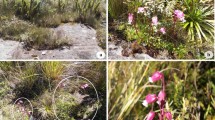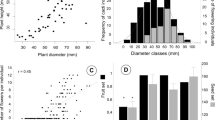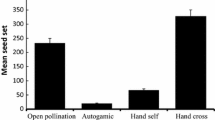Abstract
Ecologically, the interaction between plant and pollinators is mutually beneficial for the survival and adaptability. It leads to a higher level of fitness of both interacting partners. Birds play significant roles in plant reproduction and the fitness of ecosystem in tropical forest. This study was carried out with the objective to analyze legitimate floral visitors of Bombax ceiba Linn. in tropical forests of Indo-Burma region of India in relation to pollen production and mating system. The study was performed at two different locations, namely Bethlehem Vengthlang (23°43′N latitude and 92°43′E longitude) and Tanhril (43° 37’ N latitudes and 38° 39’ E longitudes). Both study sites are located 30 km apart from each other. Analysis revealed that the pollination in B. ceiba was mostly carried out by the birds, and the flowers were visited and foraged by thirteen (13) species of birds belonging to five families of the order of Passeriformes. One species of squirrel (Funambulus sp.) was also recorded visiting the flowers of B. ceiba. Study on mating-system evaluation revealed that the B ceiba is an outcrossing tree species, requiring the services of adequate pollinators for successful pollination and reproductive fitness. However, geitonogamy was partly functional. The index of self-incompatibility (ISI) value exposed that the species is mostly self-incompatible. All the species of birds were efficient pollinators for B. ceiba in the present study sites. The fruit and seed sets following natural pollination are fairly high compared with other bird-pollinated species. High pollen-production capacities per flower and per tree along with the high visitation of bird pollinators would have promoted the maximum reproductive success in B. ceiba. This also depicts that the species does not have the problem of pollen and resource limitations in Indo-Burma region of North-East India. B. ceiba tree is often used in urban forestry, and these results can be used for a comparative study of natural and human-altered ecosystems.

Similar content being viewed by others
References
Aguilar R, Ashworth L, Galettto L, Aizen MA (2006) Plant reproductive susceptibility to habitat fragmentation: review and synthesis through a meta-analysis. Ecol Lett 9(8):968–980
Ali S (1932) Flower-birds and bird-flowers in India. J Bombay Nat Hist Soc 35:573–605
Bawa KS (1990) Plant-pollinator interactions in tropical rainforests. Annu Rev Ecol Syst 21:399–422
Bawa KS (1995) Pollination, seed dispersal and diversification of angiosperms. Trends Ecol Evol 10:311–312
Bawa KS, Opler PA (1975) Dioecism in tropical forest trees. Evolution 29:167–179
Bergamo PJ, Rech AR, Brito VLG, Sazima M (2016) Flower colour and visitation rates of Costus arabicus support the ‘bee avoidance’ hypothesis for red-reflecting hummingbird-pollinated flowers. Funct Ecol 30:710–720
Bhattacharya A, Mandal S (2000) Pollination biology in Bombax ceiba Linn. Curr Sci 79:1706–1712
Buzato S, Sazima M, Sazima S (2000) Hummingbird-pollinated floras at three Atlantic forest sites. Biotropica 32:824–831
Cronk Q, Ojeda I (2008) Bird-pollinated flowers in evolutionary and molecular context. J Exp Bot 59:715–727
Etcheverry ÁV, Alemán CET (2005) Reproductive Biology of Erythrina falcata (Fabaceae: papilionoideae). Biotropica 37:54–63
Etcheverry ÁV, Figueroa-Castro D, Figueroa-Fleming T, Alemán MM, Juárez VD, López-Spahr D, Yáñez CN, Gómez CA (2012) Generalised pollination system of Erythrina dominguezii (Fabaceae: papilionoideae) involving hummingbirds, passerines and bees. Aust J Bot 60:484–494
Faegri K, van der Pijl L (1979) The principles of pollination ecology. Pergamon, Oxford
Galetto L, Bernardello G, Isele IC, Vesprini J, Speroni G, Berduc A (2000) Reproductive Biology of Erythrina crista-galli (Fabaceae). Ann Mo Bot Gard 87:127–145
Hedegart T (1973) Pollination of teak (Tectona grandia L.). Sylvae Genet 22:124–128
Howe HF (1984) Constraints on the evolution of mutualism. Am Nat 123:765–777
Jain V, Verma SK, Sharma SK, Katewa SS (2011) Bombax ceiba Linn.: as an umbrelsla tree species in forests of southern Rajasthan, India. Res J Environ Sci 5:722–729
Janzen DH (1970) Herbivores and the number of tree species in tropical forests. Am Nat 104:501–528
Kearns CA, Inouye DA, Waser NM (1998) Endangered mutualisms: the conservation of plant–pollinator interactions. Annu Rev Ecol Syst 29:83–113
Khanduri VP, Kumar KS, Sharma CM (2015) Role of pollen production in mating success in some tropical tree species. Braz J Bot 38:107–112
Kumar KS (2016) Reproductive phenology, pollen production and pollinators availability in some tropical tree species in Aizawl, Mizoram. PhD thesis submitted to Mizoram University, Aizawl
Lunau K, Papiorek S, Eltz T, Sazima M (2011) Avoidance of achromatic colours by bees provides a private niche for humming birds. J Exp Biol 214:1607–1612
Murcia C (1996) Forest fragmentation and the pollination of Neotropical plants. In: Schelhas J, Greenberg R (eds) Forest patches in tropical landscapes. Island Press, Washington DC, pp 19–36
Nagarajan B, Nicodemus A, Mandal AK, Verma RK, Gireesan K, Mahadevan NP (1998) Phenology and controlled pollination studies in Tamarind. Silvae Genetica 47:5–6
Raju AJS, Rao SP, Rangaiah K (2005) Pollination by bats and birds in the obligate outcrosser Bombax ceiba L. (Bombacaceae), a tropical dry season flowering tree species in the Eastern Ghats forests of India. Ornithol Sci 4:81–87
Rangaiah K, Raju AJS, Rao SP (2004) Passerine bird-pollination in the Indian coral tree, Erythrina variegata var. orientalis (Fabaceae). Curr Sci 87:736–739
Renner SS (1998) Effects of habitat fragmentation on plant pollinator interactions in the tropics. In: Newbery DM, Prins HH, Brown ND (eds) Dynamics of Tropical Communities. Blackwell Science, Oxford, pp 339–360
Roubik DW (ed) (1995) Pollination of cultivated plants in the Tropics, FAO Agricultural Services Bulletin, Smithsonian Tropical Research Institute, Balboa, Panama, p 118
Sekercioglu CH (2006) Increasing awareness of avian ecological function. Trends Ecol Evol 21:464–471
Specht CD (2006) Systematic and evolution of Costaceae (Zingiberales): a multiple dataset approach. Syst Bot 31:89–106
Stiles FG (1978) Ecological and evolutionary implications of bird pollination. Am Zool 18:715–727
Subramanya S, Radhamani TR (1993) Pollination by birds and bats. Curr Sci 65:201–209
Tangmitcharoen S, Owens JN (1997) Pollen viability and pollen tube growth following controlled pollination and their relation to low fruit production in teak (Tectona grandis L.f.). Ann Bot 80:401–410
Tormo Molina R, Munˇoz Rodriguez A, Silva Palacios I, Gallardo Lopez F (1996) Pollen production in anemophilous trees. Grana 35:38–46
Turner IM (2004) The ecology of trees in the tropical rain forest. Tropical biology series, Cambridge
Venkateswarlu J, Bhiravamurthy PV, Narasimha Rao P (1972) The Flora of Visakhapatnam. Andhra Pradesh Academy of Sciences, Hyderabad
Whitham TG, Bailey JK, Schweitzer JA, Shuster SM, Bangert RK, LeRoy CJ, Lonsdorf E, Allan GJ, DiFazio SP, Potts BM et al (2006) A framework for community and ecosystem genetics: from genes to ecosystems. Nat Rev Genet 7:510–523
Wolf LL, Hainsworth FR, Gill FB (1975) Foraging efficiencies and time budgets in nectar-feeding birds. Ecology 56:117–128
Zapata TR, Arroyo MTK (1978) Plant reproductive ecology of a secondary deciduous tropical forest in Venezuela. Biotropica 10:221–230
Zar J (1999) Biostatistical analysis, 4th edn. Prentice Hall, Upper Saddle River
Acknowledgments
This work was supported by the Council of Scientific and Industrial Research (CSIR), Government of India, New Delhi, vide their Project No. 38(1186)/08/EMR-II. The authors are highly grateful to the anonymous reviewers of the earlier draft of this manuscript for their valuable suggestions and to Dr Arun Pant, Associate Professor, the Department of English, HNB Garhwal University, SRT Campus Badsahithaul, Tehri Garhwal, for their in-depth reading of the manuscript, which helped to improve the quality of the paper immensely.
Author information
Authors and Affiliations
Corresponding author
Rights and permissions
About this article
Cite this article
Khanduri, V.P., Kumar, K.S. Reproductive effort and success in Bombax ceiba L. in a tropical forest of Mizoram, Indo-Burma region of North-East India. Braz. J. Bot 40, 157–166 (2017). https://doi.org/10.1007/s40415-016-0327-2
Received:
Accepted:
Published:
Issue Date:
DOI: https://doi.org/10.1007/s40415-016-0327-2




